





If you have a small garden but want year-round attraction, there are multitudes of dwarf conifers that can fit the bill. This is part one or a two part series on the more common dwarf conifers that mature at about 1 m in height. This article will cover some examples from the 'needled' conifer genera which include Abies, Cedrus, Cryptomeria, Larix, Picea, Pinus, Pseudotsuga, Taxus and Tsuga.
Evergreens are the back bone of any garden, providing a permanent skeleton for the garden while at the same time, providing year-round interest. Huge park setting with drifts of Austrian pine, Colorado spruce or Douglas fir can look beautiful in summer or winter. However, most of us gardeners (myself included) garden on a postage stamp! Conifers reaching 30 m plus is not an option. However, thankfully, there are a multitude of dwarf conifers, many which grow less than 8 cm per year and rarely exceed 1 m. Such conifers are ideal for foundation plantings, as stand-alone specimens or for rock gardens.
First, a little background on conifers and their dwarf forms. Conifers, as a group, fall into three main families; cypress (Cupressaceae), pine (Pinaceae) and yew (Taxaceae). For simplicity, we'll say the cypress family have mostly scale-like leaves and small cones or berry-like cones, the pine family has typical needles and cones while the yews have needles but fleshy fruit rather than cones. Dwarf forms of false cypress (Chamaecyparis spp.) and junipers (Juniperus spp.) are probably more numerous than any other conifer group and will be the subject of a separate article. In this particular article I will concentrate on dwarf members of the pine and yew family. Many of the dwarfs about to be described are hardy into zone 3 areas, some even into zone 2, allowing them to be used in gardens throughout much of the temperate world.
There are literally hundreds of dwarf conifers on the market, some of them common, others quite rare. First of all, as a warning, the term dwarf is relative. As an example, the standard Norway Spruce, Picea abies, may reach 20-30 m in height. It's cultivar, ‘Ohlendorffii' is often described as dwarf, but at 5 m, while dwarf compared to the regular Norway Spruce, it is still much too large for a small garden. On the other hand, it's cultivar ‘Little Gem' will form a tight bun mostly under 1 m, putting on about 2-3 cm of growth per year. This makes it an ideal candidate for a rock garden or foundation planting.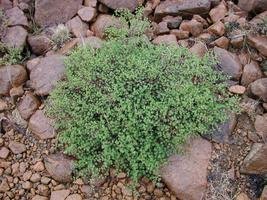
So where do the dwarf forms originate? Some of the dwarf cultivars on the market have arisen as genetic anomalies. For example, a flat of white spruce seeds germinate but one of the seedlings grows small and rounded rather than upright and pyramidal. The seedling is a genetic misfit and in the wild, probably would not survive. However, as gardeners, we see potential in that seedling as an attractive garden dwarf that, with proper care, may grace our gardens for years to come. Other dwarf cultivars arise as naturally-occurring dwarf forms that are adapted to their particular extreme environment yet are genetically fixed to stay dwarf even when moved to more gentle climates. 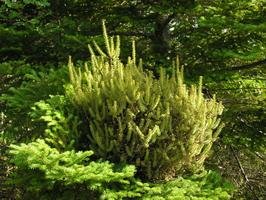
Perhaps the most common source of dwarf conifers is from witches-brooms. Many conifer species can produce dwarf, stunted branches that arise on an otherwise normal tree. As these aberrant growths mature, they often take on a nest-like appearance, hence the common name. Oftentimes, these witches-brooms can be rooted and the resulting plants will maintain the dwarf form independent of their parent. However, some witches-brooms arise as a disease, such as on balsam fir, in which case, the witches-brooms cannot be propagated.
The culture of dwarf conifers is quite simple. Generally, they are quite happy in any regular garden soil that is reasonably moist yet well drained. Dwarf pines are quite drought resistant. Slightly acidic soil conditions appear ideal for the majority of dwarf conifers. Full sun is a must for many, except for the dwarf forms of yew and hemlock which can tolerate some shade. The main consideration is to give them space. Here's a conundrum! While small in size, dwarf conifers resent close neighbors. If other plants rest against them, it may result in a thinning or death of the branches on that side of the plant. If the conifer is a bun-forming type, they may be ruined. If prostrate, the affected branches may be pruned without severely affecting the plant. Cold winter winds may cause winter-burn on a number of dwarf conifers so it may be best to avoid west to northwest exposures in colder zones. Thankfully, their small size can make winter protection as easy as simply placing a teepee of evergreen boughs around them to block the colder winds. Conversely, a teepee of sticks covered in burlap can serve the same purpose. If wrapping in burlap, its best not to let the burlap touch the foliage.
In my growing area of St. John's, Newfoundland (zone 5b) we can grow quite a number of dwarf conifers. Alpine enthusiasts from the mid-West and prairie Provinces will be more restricted, but there are at least a few dwarf conifers that can be grown just about anywhere in North America. With so many dwarf cultivars available, it can be a daunting task to describe them all, so I'll stick to the more commonly available ones that either I have grown personally, or are growing in the gardens of local gardening friends. These cultivars will generally be ‘standards' in the nursery trade. Please remember that this is just the tip of the iceberg in regards to dwarf cultivars out there. There are literally hundreds to choose from and new ones arise every year.
Perhaps the most widely available and popular of the dwarf firs is Abies balsamea 'Nana'. This cultivar, which will grow 2-5 cm per year, will top off at about 60 cm and form a dense, flat globe. New needles are bright green and contrast against the older, dark green, somewhat shiny needles. They prefer cooler summer climates and shade from intense sun. Zone 3. In milder zones (zone 5) you can try A. koreana ‘Prostrata'. The needles of this fir are similar to the previous conifer but are a little lighter green. The growth habit, as the cultivar name suggests, is prostrate. While low growing it may require a large horizontal space. When mature, plants will produce large, upright purple cones. The cultivar ‘Prostrate Beauty' is very similar. With a more globose, nest-like form there is the beautiful 'Silberparl' with silvery-green foliage. For a contrasting foliage effect there is A. nordmanniana ‘Golden Spreader'. The growth form of this cultivar is very similar to A. koreana ‘Prostrata', but the needles are a beautiful golden-yellow. Highly recommended.
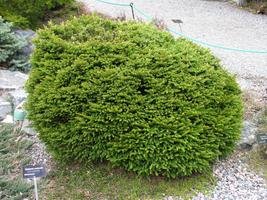
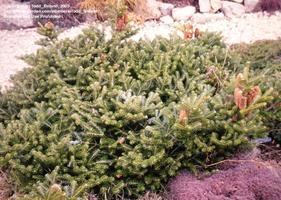
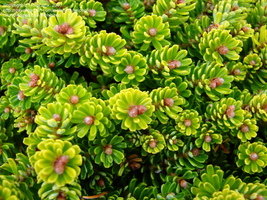
Above are Abies balsamea 'Nana', A. koreana 'Prostrate Beauty' and A. koreana 'Silberpurl' (last photo courtesy of Kniphofia)
One of the most desirable dwarf cedars is Cedrus deodara 'Pygmaea' with its steel-blue, prickly needles and congested globose bun.. The spiky needles give the plant a pin-cushion appearance. The annual growth rate is a mere 4-8 cm and plants will reach about 75 cm. Plants are rated to Zone 6 and require protection from cold winter winds in my growing area. C. libani ‘Nana' is a slow-growing, densely-bushy, cultivar with a growth rate of only 2-4 cm per year. Its needles are dark green above and grey-green below. When mature is will be as wide as it is tall. As with the above cultivar, this one too benefits from some winter protection in my area, as it is rated Zone 6.
Cryptomeria japonica ‘Vilmoriniana' is probably the most popular dwarf in this genus. Plants will form an irregular globe with dense olive-green needles that turn bronzy-purple in winter. They are very slow growers, reaching about 30 cm in 10 years. 'Pygmaea forms a more distinct globe while 'Compressa' forms a dense, globose to conical outline. The cultivar 'Nana' also forms an irregular globe but is a little larger than the previous two, reaching 1 m in about 25 years. These cultivars are listed as hardy to zone 6 but are surviving in my zone 5b via a little extra winter protection.
Larix laricina ‘Newport Beauty' is not for the small rock garden, as this plant can reach 1.5 m or greater, but for a large rockery, it's wonderful. This larch will form a dense, globe of soft, blue-green needles that turn yellow in autumn. Larix decidua 'Compacta' is similar but has bright green foliage. Both are rated for zone 3.
There are several dwarf forms of Norway spruce, Picea abies. The popular 'nest spruce', P. abies 'Nidiformis' is relatively small but 'Pumila' is a half-sized version. 'Greygoriana' forms a very slow growing, dense, irregular bun, often with a flattish-top. The needles are prickly and a sea-green color. A growth rate of 2 cm a year is the norm. The cultivar ‘Echiniformis' is very similar. For a more globular form try 'Clanbrassiliana' or 'Eva'. Perhaps the most popular of the dwarf Norway spruce is 'Little Gem'. It's a wonderful plant, forming a dense, mid-green flattish mound when young, but later becoming more hemispherical. If lucky, it will put on 2 cm of growth a year. Zone 4.

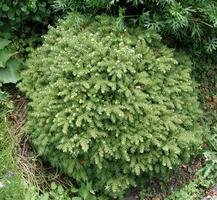
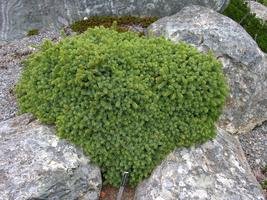
Above are Picea abies 'Clanbrassiliana', 'Little Gem' and 'Echiniformis'
The most popular dwarf white spruce is probably the dwarf Alberta spruce, P. glauca 'Conica'. However, this selection can certainly top 3 m in time. A dwarfer version is 'Gnom' or 'Jean's Dilly'. If rounded dwarfs is preferred, try ‘Alberta Globe', a slow growing cultivar with a dense, rounded habit and bright green foliage. The cultivars ‘Little Globe' and 'Elf' are similar but even smaller. Listed for zone 3 but they appreciate some protection if grown in windy sites.
The best dwarf black spruce is Picea mariana ‘Nana'. This selection has a low, dense, cushion-like habit with dark blue-green to grey-green needles. It will tolerate wetter soils than most dwarf conifers. It is often sold as a 'dwarf nest spruce'. Zone 3. Picea omorika ‘Pumila', a dwarf form of Serbian spruce, has procumbent lower branches and more upright upper branches. Bright grass green needles with bluish-white undersides are arranged semi-radically and are accented by the bright orange buds. Although growing only 2-4 cm per year, this broadly conical cultivar may reach 1-1.5 m. More dwarf with an irregular globular form is 'Pimoko'; zone 4. The dwarf Sitka spruce Picea sitchensis 'Tenas' has wonderful foliage that is shiny lime-green on the top and silver-blue on the bottom. Quite dense and prickly, the habit of this cultivar is somewhat conical. The slow growth rate is 4-8 cm per year. Plants may get large over time,so it probably best used in a larger rock garden. It also goes by the name ‘Papoose'. Although rated for zone 6, I have seen this cultivar doing quite well in a zone 5 area.
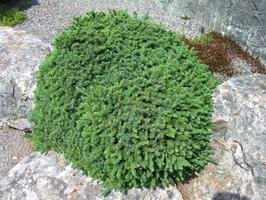
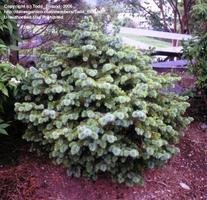
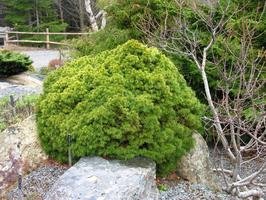
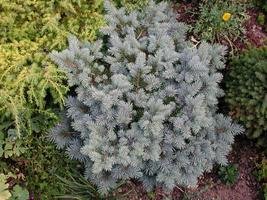 P
P
Portrayed above are Picea mariana 'Nana', P. sitchensis 'Tenas', P. glauca 'Alberta Globe' and P. pungens 'St. Mary's Broom'
Among the Colorado spruce, Picea pungens, there are many dwarfs, but not all will stay small. An example is 'Montgomery' which is quite low and somewhat rounded when young but becomes more pyramidal, reaching 3 m or more, with time. Picea pungens ‘Globe' is a dense, mound-forming cultivar with sharp, blue-green needles and 5 cm annual growth rate, making this one of the better dwarf Colorado spruces. Somewhat similar is 'Mrs. Cesarini'. ‘St. Mary's Broom' is among the most dwarf ‘blue spruce' on the market. This conifer will produce a dense, low-mounding cushion and rarely grows more than 5 cm per year. Foliage is sharp and prickly and a wonderful steel-blue. Mine is 15 years old and still under 45 cm. Highly recommended. Zone 3.
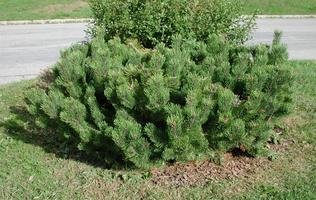 There are many pines to choose from when selecting a dwarf conifer. As a group, the pines are primarily divided into two groups; the hard pines with paired, stiff needles and rounded cones and the soft pines with bundles of 5 flexible needles and elongate cones. First we'll discuss the dwarf hard pines. Pinus banksiana ‘Chippewa' is a super dwarf jack pine with quite short needles for a pine. The plants form is bun-shaped and dense. It is one of the hardiest dwarf conifers, being rated for zone 2. It should be noted, that most pines can be sheared annually to help slow their growth rate and increase their density. However, several of the most dwarf cultivars should never require shearing. The standard mugo pine, P. mugo, may look innocent enough when first purchased, but if left unchecked, can get quite large. Thankfully, there are a number of more compact cultivars that may never require any pruning. ‘Flat Top' is one such cultivar and will form a dense flat-topped bun with deep green twisted needles. The cultivars ‘Kissen' and ‘Sherwood Dwarf' are very similar and equally desirable. Among the dwarf mugo pines, ‘Mops' has the unique feature of straight needles. Being very dense and evenly rounded without any shearing makes this a most desirable mugo pine. All mugo pines are hardy to zone 3. The dwarf Scots pine, P. sylvestris 'Nana Compressa' has a horizontal branching habit, creating a layered effect. The overall form is a flat-topped mound. Plants typically reach about 70 cm in 10 years. ‘Pixie' is one of the smallest Scots pines I've seen. It is a slow growing mound of short blue-green needles. 'Hillside Creeper' has a low, spreading habit and will only each 20 cm after 20 years! The Scots pines are hardy to Zone 4.
There are many pines to choose from when selecting a dwarf conifer. As a group, the pines are primarily divided into two groups; the hard pines with paired, stiff needles and rounded cones and the soft pines with bundles of 5 flexible needles and elongate cones. First we'll discuss the dwarf hard pines. Pinus banksiana ‘Chippewa' is a super dwarf jack pine with quite short needles for a pine. The plants form is bun-shaped and dense. It is one of the hardiest dwarf conifers, being rated for zone 2. It should be noted, that most pines can be sheared annually to help slow their growth rate and increase their density. However, several of the most dwarf cultivars should never require shearing. The standard mugo pine, P. mugo, may look innocent enough when first purchased, but if left unchecked, can get quite large. Thankfully, there are a number of more compact cultivars that may never require any pruning. ‘Flat Top' is one such cultivar and will form a dense flat-topped bun with deep green twisted needles. The cultivars ‘Kissen' and ‘Sherwood Dwarf' are very similar and equally desirable. Among the dwarf mugo pines, ‘Mops' has the unique feature of straight needles. Being very dense and evenly rounded without any shearing makes this a most desirable mugo pine. All mugo pines are hardy to zone 3. The dwarf Scots pine, P. sylvestris 'Nana Compressa' has a horizontal branching habit, creating a layered effect. The overall form is a flat-topped mound. Plants typically reach about 70 cm in 10 years. ‘Pixie' is one of the smallest Scots pines I've seen. It is a slow growing mound of short blue-green needles. 'Hillside Creeper' has a low, spreading habit and will only each 20 cm after 20 years! The Scots pines are hardy to Zone 4.
Among the soft pines there is P. cembra ‘Nana', a very slow growing cultivar of Swiss stone pine with beautiful blue-green foliage. Plants have a tight, pyramidal habit and are hardy to zone 4. P. parviflora ‘Hagarumo' is one of the best dwarf Japanese white pines. It forms a miniature bun, and grows only 1-3 cm a year. The short needles are a lovely blue-green. It is a popular cultivar for bonsai; zone 5. P. strobus ‘Glauca Nana' is one of the most readily available dwarf white pines and while it has a globe-like form, it may require regular shearing to maintain a dense habit. Even so, it will get large over time so is probably best reserved for the larger rock garden. ‘Horsford' is a neat bun shaped cultivar with attractive lime-green needles and an annual growth of only 2 cm; very choice. ‘Sea Urchin' is a very dwarf cultivar that forms a dense bun of lovely short, bluish needles; 'Minuta' is similar but more blue-green. All the dwarf eastern white pines are hardy to zone 3. It should be noted that all of the dwarf soft pine selections resent windy locations.
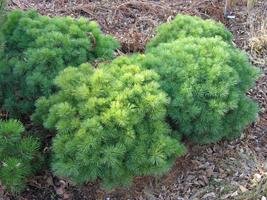
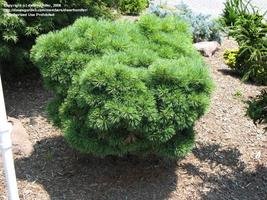
With an annual clipping, you can keep Pinus strobus 'Glauca Nana' and 'Horsford' quite compact ('Horsford' pic courtesy of dwarfconifer)
The Douglas fir, Pseudotsuga menziesii ‘Hillside Pride' is a choice gem, being very dense and mound-like and having an annual growth rate of only 2-4 cm. Needles are shiny and very deep green. ‘Idaho Gem' is one of the smallest and slowest growing Douglas fir cultivars forming a tight bun often under 30 cm in height. Its diminutive size makes it a perfect candidate for trough culture. Zone 5.
There are not many truly dwarf yews. Taxus cuspidata ‘Minima' is perhaps the smallest growing yew cultivar on the market. The habit is somewhat upright but the growth rate is only 2-5 cm per year. The needles are a shiny dark green. ‘Nana' is larger than ‘Minima' but still relatively dwarf. This cultivar has a tight, globe-like form of dark green needles. This cultivar, along with ‘Minima' can withstand considerable shade. In sunnier sites try the golden-foliaged 'Nana Aurescens' which has a dwarf, spreading habit. Zone 4.
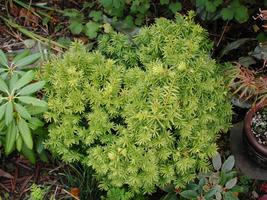
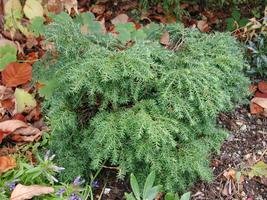
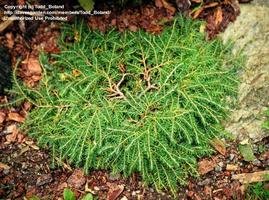
Pictured above are Taxus cuspidata 'Nana Aurescens', Tsuga canadensis 'Jeddeloh' and T. canadensis 'Cole's Prostrate'
There are numerous dwarf cultivars of eastern hemlock, Tsuga canadensis. As a group, they can tolerate a fair amount of shade but need protection from cold, dry winter winds as they suffer easily from wind-burn. ‘Cole's Prostrate' is a slow growing, completely prostrate form. But beware, although very low, the plant can occupy considerable horizontal space and often, this cultivar is grown as a ground-cover. However, it can be trimmed if it gets too out of hand. A larger version which is still relatively small, is 'Pendula'. ‘Horsford' will form a dense, squat, irregular mound of small, dark green needles. Branches are drooped at the tips. Annual growth rate is 4-6 cm and plants will reach 60 cm in 10 years. ‘Jeddeloh' is very popular and for good reason. The plants form is a flat-topped globe but the densely arranged branch tips are pendent, giving the plant a fountain-like habit. Very graceful effect. ‘Minuta' is among the most dwarf of all hemlocks with a growth rate often less than 2 cm. This cultivar is upright but quite irregular in shape with small, congested and twisted needles. Another choice trough plant. The cultivar ‘Nearing' is quite similar. Zone 4.
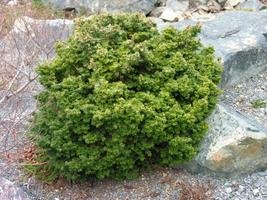
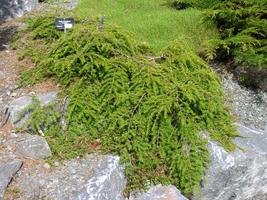
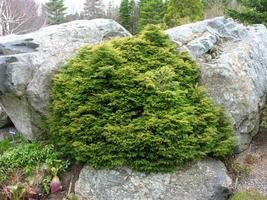
The above cultivars of eastern hemlock include 'Nearing', 'Pendula' and 'Minuta'
Copyright © www.100flowers.win Botanic Garden All Rights Reserved